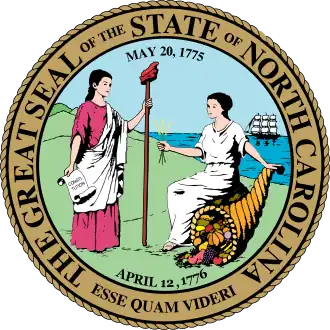1950 United States Senate special election in North Carolina
| |||||||||||||||||
| |||||||||||||||||
 County results Smith: 50–60% 60–70% 70–80% 80–90% 90-100% Galvin: 50-60% 60-70% 70-80% | |||||||||||||||||
| |||||||||||||||||
| Elections in North Carolina |
|---|
 |
The 1950 United States Senate special election in North Carolina took place on November 7, 1950 in North Carolina as part of the 1950 Senate elections. The incumbent Democratic Senator J. Melville Broughton died two months into his term on March 6, 1949. Frank Porter Graham, the president of the University of North Carolina, was appointed to the vacant seat. Graham was defeated in the Democratic primary by former Speaker of the North Carolina House of Representatives Willis Smith, who would go on to win election by a margin of 34.4%. Smith would die on June 26, 1953, with Alton Lennon appointed to the vacancy.
Democratic primary
Candidates
- Olla Ray Boyd, pig farmer and perennial candidate[1]
- Frank Porter Graham, the incumbent Senator
- Robert R. Reynolds, former U.S. Senator
- Willis Smith, former Speaker of the North Carolina House of Representatives
Campaign

Electoral law at the time did not mandate a runoff election, with the losing candidate able to request one. Following Sweatt v. Painter, which challenged segregation in Texas, Jesse Helms led an advertising campaign through WRAL to successfully encourage Smith to call for a runoff.[2]
The primary runoff pitched a progressive New Deal Democrat (Graham) against a traditional pro-segregation Democrat (Smith).[3] Graham sought to emphasise his commitments to education and other social programmes, however Smith's relentless campaigning on issues of race ultimately prevailed.[2]
Results
| Party | Candidate | Votes | % | |
|---|---|---|---|---|
| Democratic | Frank Porter Graham (incumbent) | 303,605 | 49.09 | |
| Democratic | Willis Smith | 250,222 | 40.46 | |
| Democratic | Robert R. Reynolds | 58,752 | 9.50 | |
| Democratic | Olla Ray Boyd | 5,900 | 0.95 | |
| Turnout | 618,479 | |||
| Party | Candidate | Votes | % | ±% | |
|---|---|---|---|---|---|
| Democratic | Willis Smith | 281,114 | 51.78 | +11.32 | |
| Democratic | Frank Porter Graham (incumbent) | 261,789 | 48.22 | −0.87 | |
| Majority | 19,325 | 3.56 | |||
| Turnout | 542,903 | ||||
Results maps

Smith: 40–49% 50–59% 60–69% 70–79%
Graham: 40–49% 50–59% 60–69% 70–79%

Smith: 50–59% 60–69% 70–79%
Graham: 50–59% 60–69% 70–79% 80–89%
General election
| Party | Candidate | Votes | % | ±% | |
|---|---|---|---|---|---|
| Democratic | Willis Smith | 364,912 | 66.97 | −3.73 | |
| Republican | E. L. Galvin | 177,753 | 32.62 | +3.82 | |
| Write-In | Frank P. Graham (incumbent) | 2,259 | 0.41 | +0.41 | |
| Majority | 187,159 | 34.35 | |||
| Turnout | 544,924 | ||||
| Democratic hold | Swing | ||||
References
- ^ "The Pork Chop Conspiracy". New York Times. 10 October 1976. Retrieved 9 August 2025.
- ^ a b Martin, Johnathan. "The 1950 Smith-Graham Senate Race". North Carolina History Project. Retrieved 9 August 2025.
- ^ "Primary Source: The 1950 Senate Campaign". NCPedia. Retrieved 9 August 2025.
- ^ a b North Carolina Manual 1951. North Carolina Historical Commission. pp. 235–238. Retrieved 9 August 2025.
- ^ "STATISTICS OF THE CONGRESSIONAL ELECTION OF NOVEMBER 7, 1950" (PDF). Clerk of the US House of Representatives. p. 26. Retrieved 9 August 2025.
